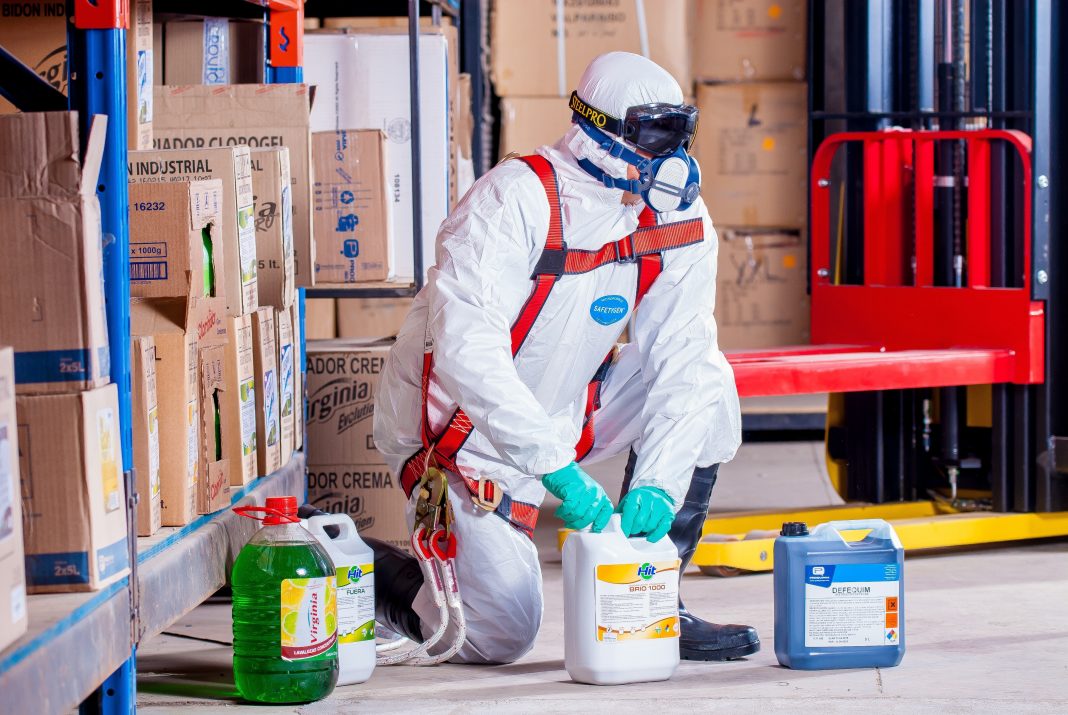 |
|
| Issue #81 • May/June, 2003 |
The weather here on the coast of Oregon is nice almost all year-round, and there almost always seems to be some kind of fishingsalmon or winter steelhead running on the Rogue, or rock cod, ling cod, halibut, cabezon, and more out in the ocean. So I wasn’t surprised when I arrived at the magazine one morning, and parked at the curb in front of the office was the truck belonging to O.E. MacDougal, our poker playing friend from southern California.
I paused to look in the passenger’s side window of his truck. There was a tackle box on the seat along with a bottle of Tabasco Sauce that looked as though it had been opened, and a few unopened cans of sardines.
“Mac here?” I asked Muriel as I went in the front door.
“No, but his truck is. I think he went that way on foot,” she replied pointing north toward town.
A while later Dave Duffy came in. Dave’s the guy who publishes this magazine.
“That’s Mac’s truck out front, isn’t it?” he asked.
“Yeah,” I said.
“Is he here?”
“I don’t know where he is,” I said. “Muriel thought she saw him walking downtown.
“Want to go for coffee?” Dave asked. “Maybe we’ll catch him. There aren’t that many places he goes to breakfast when he’s up here.”
Just then Mac walked into the office.
“Hey, Mac,” Dave said. “We were just going to head out and see if we could find you.”
Mac looked around, then sat in the stuffed chair near my desk. We made some desultory small talk about Mac’s trip, about the weather, and the fishing prospects, while Dave and I got ready for our workday.
Dave’s wife Ilene, the business manager for the magazine, came in and stood there a second staring at Mac.
“You’re here!” she exclaimed. “When did you show up?”
“About an hour and a half ago. I went downtown, ate, then took a walk.”
“Well, you’ll have to come up for supper tonight,” she said. “We’re having salmon patties.”
With that, she went to her office.
Dave started going through his mail and I was looking through the in-basket of submissions. Mac looked as though he was about to nod off.
“Hey, Mac, what do you think of all this terrorist stuff?” Dave suddenly asked.
Mac acted startled for just a second. He must have driven through most of the night. “Well, it’s certainly something to be concerned about,” he replied.
He sat there gathering his thoughts for a moment. “The 9/11 thing they pulled off was spectacular,” he said. “But it’s hard to tell whether they’ll be able to pull off anything that dramatic again.”
“What about the possibility of biological warfare or a chemical attack?” Dave asked as he still sorted through the envelopes on his desk.
Mac looked in Dave’s direction. “Well, you know what people keep saying, ‘We didn’t expect them to use airliners as flying bombs, so we can’t predict what they may come up with next.’ There’s a whole lot of truth in that statement.”
“So, do you think they’ll do something again? Something that involves biologicals or chemical weapons?” Dave asked.
Mac shrugged. “I think they will if they can figure out how to do it, and then if the opportunity presents itself. I think flying planes into buildings was easier to plan and execute than committing an attack with biological or chemical weapons is going to be. But I don’t think they’re likely to be able to repeat their success with airliners again.”
“What makes the chemical and biological weapons difficult?” I asked.
“Consider the difficulties the Aum Shinrikyo sect, in Japan, had with their sarin gas attack on a Tokyo subway. It wasn’t their first try. They’d bungled some previous attempts. Some that included botulism and anthrax attacks. But even when they released sarin gas, a deadly nerve gas, in the confines of a subway, though they injured almost 6,000 people, they only killed a dozen.
“Their attacks did cause some damage, but the sect had recruited bright young scientists and engineers to poison people in a densely populated country, and they had less than impressive results. Certainly not even close to the scale that Al Quaida would have with airliners on September 11th. I can’t see how it’s going to be easy for Muslim terrorists to do a whole lot better than Aum Shinrikyo did. But they’re certainly going to try. And I’ll bet they’ve learned from Aum Shinrikyo’s mistakes.”
“What kinds of attacks might they stage using biological and chemical weapons?” I asked.
Mac thought a moment. “Let’s start with biologicals,” he began. “There are two types. The first involves diseases like anthrax and botulism where victims must come into direct contact with the stuff to be affected. Botulism, for example, can’t be passed from person to person, and anthrax only does so rarely.
“The second type, however, and the kind we should fear most involves the use of pathogens like smallpox or the ebola virus. What you’re trying to do when you use these biologicals is start a self-sustaining epidemic.” He thought another moment. “A pandemic.”
“What’s the difference between an epidemic and a pandemic?” I asked.
“It’s really a matter of magnitude. When you think of an epidemic, think of some kind of disease spreading. When you hear pandemic, think ‘epidemic spread out over a huge geographical areaeven worldwide. It’s also used sometimes when describing an epidemic that affects most of a very large population.
“So, if there’s an outbreak of ringworm at the local elementary schools, someone may call it an epidemic. You might even call an outbreak of the ebola virus in Africa an epidemic as it spreads from person to person through several villages. In contrast, each year one or another of a strain of flu sweeps the world. That’s an epidemic, but because of how widespread it is, it would be more appropriate to call it a pandemic.”
“Have we always had epidemics?” I asked.
“They’re not new to mankind. They’ve been with us at least since the first cities in the Old World. We know little about any of those early ones, today, but they were a greater part of human history than is usually taught in school.
“Before the rise of civilization, when humans lived in small isolated groups, there was little chance of epidemics spreading. If a disease leaped from animals to humans in a small village, the whole village may have been wiped out, but it’s unlikely that any of them spread far or became pandemics.”
“So most of them would have been localized,” Dave said.
“That’s right.
“But when we started building cities, diseases took on a new face. In cities, with their concentrations of people, there were more social interactions, both within and between groups, and diseases had greater chances to spread. With their large concentrated populations, epidemics became self-sustaining because there were more people to infect. Epidemics could spread because of the sharing of communal water supplies and food, and there was also the infestation of rodents who, along with their parasites, often harbored diseases like plague. Other diseases, such as smallpox, seem to spread only because of social contacts, and cities offered lots of chances for multiple social contacts.”
“But how far back in history do we know about epidemics?” Dave asked.
“We know there have been plagues since at least the beginning of recorded history. There are accounts of plagues and epidemics in the Bible. We know from his mummified body that Ramses V, one of the Pharaohs of ancient Egypt, suffered the ravages of smallpox.
“And, though most of the history we learned in school was about battles, kings, andlatelythe social issues that changed the course of history, what we’re not told is that many of the great battles that made the world what it is today were determined not by great generals, novel military strategy and tactics, or advanced weapons, but by diseasesepidemics. We are also not told that many of the sweeping social changes that took place in the past, from the end of feudalism to the settling of the New World, were not the result of grand social ideas, but the aftermath of deadly epidemics.”
“Any examples?” Dave asked.
“The defeat of the Persian armies, led by King Xerxes, that invaded Greece was due more to the hundreds of thousands of Persian soldiers who succumbed to disease along the way than it was to Greek military might. By some accounts, Xerxes brought an army numbering approximately 800,000, but some 300,000 of them died en route of plague.
“And what we are often not told is that in 430 BC, when Athens fell to the Spartans who had laid siege to the city, the fall was the result of an epidemic that swept through the city, not Spartan military prowess. Historical records aren’t clear as to what the disease was. It may have been smallpox or typhus. Some modern epidemiologists have even raised the possibility that it was the ebola virus or another of the hemorrhagic fevers that cause massive internal bleeding.
“Alexander the Great’s conquests were ended with his death at age 32 of pneumonia, most likely brought on because he was suffering from a bout of influenza or malaria. And for the years he marched through Europe, Asia, and Africa, disease was a constant companion of his troops. One of them just finally got him.
“Another good example is the decline of the Roman Empire. Historians have attempted to attribute it to a decline in values and to corruption, but the fact is that epidemics had decimated the Roman Army as well as the civilian population from which it was drawn. This not only led to having to staff the army with foreign mercenaries instead of Roman citizens, but their European enemies, who were largely unaffected by the epidemics sweeping the Empire, were emboldened to carry their wars to the weakened Romans. Some historians speculate that bubonic plague may have been the prime cause of the fall of the Roman Empire, not decadence.
“And the epidemics that spread back then were more brutal than we can imagine. In the sixth-century writings of John of Ephesus we find accounts of the Plague of Justinian that would boggle the modern mind. There were cases of ships that floated at sea for weeks, their entire crews dead from plague, until they washed ashore. And although we can’t be sure of the accuracy of his numbers, he also reported the death toll in Constantinople, modern day Istanbul, was 5,000 to 16,000 a day and that the guards at the city’s gates stopped counting the dead when the number of corpses passing out of the city for disposal had reached some 230,000.
“Today’s scholars and demographers estimate that about one third of Constantinople’s population died in the four months the plague reigned.
“Later, the Crusaders who marched out of Europe and into the Holy Land fell in greater numbers to microbes than they ever did to Saracen swords. One Crusade saw 100,000 people leave Europe and only 5,000 return. The overwhelming majority died of diseases either en route to, or when they reached the Holy Land.
“And when the feudal system came to an end in the 14th century, it wasn’t because of economic theory, it was because of the shortage of available labor due to deaths brought about by the Black Death, a plague that caught most of Europe by surprise. At least a quarter, and as much as one third, of the population of Europe died in just a few years, and feudal lords, who once all but owned the serfs, suddenly found they had to pay laborers to keep them from fleeing to the cities.”
“That many died? As much as a third of Europe? That must have been the epidemic to end all epidemics,” I said.
“Not quite. There was at least one greater one. But to have an epidemic of comparable proportions to the Black Death today in the United States today, we would have to have an epidemic that killed roughly thirty million people each year for two years,” he said. “Yet, there may have been an epidemic even greater than the Black Deathin the Americas, among the Indians.”
“Yikes,” I said. “This isn’t the history I learned in school.”
“No, it isn’t,” Mac said. “We also learned that Napoleon’s defeat in Russia was due to the Russian winter, and though it can in part be attributed to starvation and cold, the main culprit was the scourge of all armies until the middle of the 20th centurydisease.
“There have been thousands and thousands of other epidemics, many that could be classified as pandemics, that have occurred since mankind first moved into cities. And we’ve never heard of them. Some were local and confined to single cities, and whatever written records there may have been of them were lost.
New World epidemics
“It is because of the lack of written records that the great pestilences that devastated the Indians of the New World went unrecognized for so long.”
“This must be the one that exceeded the Black Death,” Dave said.
“That’s right,” continued Mac.
“Early European explorers had encountered numerous Indian villages in North America. So numerous they thought it too crowded to begin new settlemenrts. However, later, when English explorers landed on the coast of North America, there were very few Indians, but the bleached bones of human remains seemed to litter the landscape everywhere they went. The English settled on what they thought was relatively unoccupied land, and historians ignored the reports by the earlier explorers that the areas had once had large Indian populations.
“It’s only been recently that historians have realized what had happened. Diseases, inadvertently introduced by the Spanish conquerors to the Indian populations of Central and South America a hundred years before the English settled North America, had spread north and nearly obliterated the Indians. The Indians had almost no resistance to them and died by the millions.
“The entire New World, North and South America, may have been without epidemics of the sort that ravished the Old World until the first Europeans came and brought with them measles, diphtheria, influenza, mumps, smallpox, malaria, etc., and later cholera. These were diseases unknown to the Indians from Alaska to Tierra del Feugo until 1492, when the white man arrived from Europe and later brought his slaves from Africa.
“And the introduction of these diseases was catastrophic. Modern estimates place the population of the Americas as high as 118 million before 1492. A few centuries later there were fewer than 10 million.”
“One epidemic after another attacked the Native Americans. Smallpox, for one, spread so fast across the continent, and ahead of the whites. It was carried by Indians themselves, from one tribe to another so that by the time the white man reached many areas, the disease had already wiped out most of the native population.”
“Indians just disappeared?” I asked.
“When the Spanish explorer, de Soto, traveled along the Mississippi his journals say he encountered some 50 towns and villages along one 200-mile stretch of the Mississippi. But 150 years later, French explorers exploring the same stretch of the river didn’t find even one.
“By the 1790s, when the English explorer, George Vancouver, arrived on the coast of what are now the states of Oregon and Washington, there were Indian charnel houses loaded with the corpses of smallpox victims. The disease had apparently made its way across the continent through contacts the tribes had with one another.
“In the meantime, the diseases the Europeans brought infected them as well as the Indians, though because of the way these diseases had swept through Europe, generation after generation, the whites had developed some resistance to them. Death rates among whites were much lower, for all of these diseases, than they were for the Indians who had almost no resistance.
“Still, among the settlements founded by the Europeans, there was epidemic after epidemic. In what was to become the United States, from colonial times on, it was not uncommon to have an epidemic of smallpox followed in a few years by an epidemic of diphtheria, then measles, then smallpox again, then yellow fever, typhus, influenza, diphtheria again, then polio… For example, colonial Boston saw an epidemic of smallpox in 1677, measles in 1687, scarlet fever in 1702, measles again in 1713 and 1729, and so on. Fortunately, the epidemics were usually localized.
“Time and again Boston, New York, Philadelphia, Charleston, and other cities were battered by disease both before and after the Revolution.
“And as the country grew and there was more contact among citizens in the various cites and stateshence, more opportunity to transmit diseaseepidemics rose more often, then disappeared. No one knew why.
“And every now and then a local epidemic became a pandemic and affected most, if not all, of the country. Sometimes they spread around the world.
“One of the most notable epidemics to originate in the modern United States was one that came to be called the Spanish flu. It actually began at Camp Funston in Kansas and, from 1918 to 1919, it would kill more than half a million Americans and another 25 million people worldwide. By this time, of course, we knew that epidemic diseases were caused by microbes. But that did little to stop it.
Disease in war
“Then there were the epidemics that attended our wars. Disease during war is of interest because, throughout world history, and until recently, disease was almost always responsible for more deaths among the combatants than was actual battle. For every single battle-caused death among Northern troops during the Civil War, two other Yankee soldiers died of typhus, typhoid, smallpox, yellow fever, and other diseases.
“In our war with Mexico there were seven deaths from disease for every battlefield death. And in the Spanish-American War there were almost six disease-related deaths for each battlefield death.
“Even as late as World War I, disease killed seven men for every five who died in battle.
“The reasons for death by disease among the combatants, who were otherwise young and healthy, was the appalling lack of sanitation and pest control and the close quarters in the camps occupied by the troops.”
“Worse yet were the living conditions of prisoner of war camps. During its 14 months of existence, Andersonville Prison, in which Confederate forces held Union POWs, saw 45,000 Union troops imprisoned there, and 13,000 of them died of diseases related to malnutrition, overcrowding, or exposure.
“It wasn’t until World War II, with the recognition of the importance of sanitary measures, pest control, and mass inoculations against typhoid, smallpox, and other diseases, that America was involved in its first war in which the number of Americans who died in battle exceeded the number who died from disease. It’s been that way ever since.
“World War II may well be the first major war in all of history in which a country’s battle deaths, among its troops, outnumbered deaths suffered from diseases.
Disease as a weapon
“Had anyone ever tried to use disease as a weapon during their wars?” I asked.
“Yes. But the problem was that, until recently…” He paused.
And Dave said, “…no one knew what disease was or the role bacteria and viruses play in them.”
“That’s right,” Mac said. “Until just a few centuries ago, no one had even seen a bacteria, and until the invention of the electron microscope almost all but a few of the biggest viruses were invisible to even the best optical microscopes. Even after bacteria were known to exist, it was at least another 200 years before anyone made the connection between microbes and disease.
“However, that didn’t stop combatants, with a flair of novelty, from trying to employ disease as a weapon. Even centuries ago, they knew that some diseases, such as smallpox, could be spread by contact with the ooze that emanated from the pustules that formed on the bodies of its victims, and they knew that sewage and filth, as well as rotting cadavers, were related to or apparently caused at least a few diseases such as typhoid. And so biological warfare was born.”
“Without having to know microbes existed,” I said.
“That’s right.
“The polluting of wells and water supplies with corpses of both men and animals is as old as history. Romans were known to throw dead animals into the water supplies of their enemies with the intent of weakening and demoralizing them. Often, it worked.
“Centuries later, right here in the United States, Confederate troops similarly led animals to ponds where they shot them and left their bodies to rot in the water so as to deny Sherman’s advancing army any potable water supplies as it made its way to the sea.
“Sherman was less than amused by it and thought the southerners were barbaric as his troops burned farms, villages, and towns, one after another, and plundered the countryside wholesale to keep his army fed and moving.
“In 1340, during the siege of the castle of Thun L’Eveque in Hainault, in what is now northern France, attackers catapulted bodies of dead animals, including horses, over the walls with the idea of spreading disease. And though, as I’ve said, there was no germ theory of disease back then, they just knew that those who died of disease could often still spread it. They also knew that rotting bodies themselves could cause various other diseases. After a while, and after enough bodies had been lobbed into the castle, the attackers forced a truce.
“In 1346, while conducting a siege of Caffanow Feodossia, Ukrainea port on the Crimean peninsula in the Black Sea, an outbreak of plague, the Black Death, swept through the ranks of the Tartars who besieged the city. The siege failed, but before they called it off, they catapulted the bodies of their comrades who had died of the disease over the city walls and into the city itself. Terrified residents fled Caffa, but some of those fleeing were already infected and they carried the disease with them to Italy, starting the second major epidemic of the Black Death to sweep through Europe.
“In 1422, forces attacking Karlstein, in Bohemia, catapulted animal manureroughly 2,000 cartloads of it, if you can imagine italong with the decaying cadavers of men killed in battle, over the castle walls with the intention of spreading illness. But the attackers gave up after five months and that siege failed.”
“But it hadn’t been from lack of trying,” Dave said, and Mac laughed.
“Two thousand cartloads of the stuff,” he said to himself, and he started laughing, too.
“In the New World,” Mac continued, “the Spanish, Portuguese, and English had no reservations when it came to using whatever means and tactics they could employ to subdue or obliterate the native populations.
“Pizarro is said to have made gifts of smallpox infected blankets to Indians in South America, and General Jeffery Amherst, in whose honor Amherst, Massachusetts and Amherst College are both named, wrote a letter to one of his officers, Colonel Henry Bouquet, rendering advice on making gifts of smallpox infected blankets, handkerchiefs, and clothing that had come from smallpox victims in their infirmary, to the Delaware Indians, to hasten the spread of the disease which was particularly deadly among the native peoples. This started an epidemic of smallpox that decimated the Delaware and other tribes who came into contact with them. In fact, decimate isn’t a strong enough word, since its literal meaning is ‘one in ten.’ It nearly obliterated them.
“Amherst also made favorable comments concerning Bouquet’s plans to hunt Indians down using war dogs. And later he would bemoan that the English didn’t have enough war dogs to effectively pursue what he referred to as the ‘Spanish Method’ of killing Indians.
“But it wasn’t only Indians against whom the English used smallpox as a weapon. During the siege at Boston, just prior to the Revolutionary War, the British could have defeated the colonists by landing troops behind the Colonial position where they waited before the Battle of Bunker Hill. But they considered it an ungentlemanly tactic to do so. Thus, they lost the battle. But before departing by ships for New York, they had no reservations about introducing smallpox among the citizens, hoping to infect the forces of the Continental Army. However, this tactic failed because the Americans, upon reentering the city, saw the disease for what it was and immediately quarantined those who had it and stopped its spread.”
“So ungentlemanly tactics were frowned upon at the time, but biological warfare inflicted on the citizens was not,” Dave said.
“That’s right,” Mac said. “What’s acceptable is often just what’s acceptable at the time. Another thing the British objected to was the way American snipers picked off the British officers. It was okay for the troops to die, but…”
“I get the picture,” Dave said.
“And the British may have used the same tactic, again, during the American siege of Quebec where smallpox spread through the ranks of the Continental soldiers and was a major contribution in the American defeat there.”
“Weren’t the British afraid of contracting the disease themselves?” I asked.
“Well, even though Edward Jenner hadn’t yet invented his smallpox vaccine, which was made from the pustules of cattle infected with cowpox, it was understood that if you exposed people to the pus from mild cases of smallpox, you could confer a certain amount of immunity on the recipients. The British Army had already made it a common practice to inoculate their troops in this way.”
“Oh, and it worked?” I asked.
“Yeah, it worked pretty well, though sometimes those inoculated this way developed deadly cases of the disease.”
“And this too was done without realizing that it was microbes causing the disease,” Dave said.
“That’s right,” Mac said. “And if we fast-forward to the 20th century, when the role of viral and bacterial pathogens in the spread of many diseases was understood, it wasn’t long before someone used this knowledge to create biological weapons.
“During World War I the Germans attempted to spread livestock diseases, such as glanders and anthrax, among horses, mules, sheep, and cattle to upset the Allies food supplies. And, you’ve got to realize, even as late as World War II horses and mules were still used to transport supplies along the battle fronts. So anything that killed or maimed the animals offered a tactical advantage. However, the attempt had little success.”
“In the meantime, the Germans brought a new type of weapon to the battlefield. This was the chemical weapon. Specifically, mustard gas.”
“Is this the first use of chemical weapons in history?” I asked.
“Not at all. The first recorded use of chemical weapons was in 600 BC when Solon, the legislator of Athens, used helleboreshellebore is a toxic plantto contaminate the River Pleithenes. Drinking from the river gave the defenders of Kirrha explosive diarrhea making them unable to fight. The Athenians kicked their butts.”
“Later, during the Peloponnesian War, the Spartans created sulphur dioxide, a toxic gas, by burning wood saturated with pitch, naphtha, and sulphur. They used it during the siege of Platea, Pelium, and other cites that were allies to the Athenians.
“Then, around 200 BC, the Carthaginians did poorly in a battle and before their retreat, they left behind wine they had poisoned with mandragora, a root that contains a narcotic. Their enemy drank the wine, the narcotic took affect, they fell into a sleep, and the Carthaginians came back and slaughtered them all while they were unconscious.
“By the way, the very first recorded use of chemical warfare in North America took place in 1623 when the Jamestown colonists invited an Indian leader named Chiskiak, along with his family and some two-hundred members of his tribe, for treaty talks and a feast. The colonists offered toasts of eternal friendship and fed their guests. But, what they had done was to poison the food and drink they served to the Indians. And before the ‘feast’ was over Chiskiak, his family, and two-hundred others from his tribe were dead.
“And this wasn’t an isolated case. Some territorial newspapers in the Old West advised settlers on how to leave strychnine-laced food near Indian trails so that Indians could be exterminated. One newspaper boasted of the manner in which Minnesota settlers had poisoned over 100 Indians. The article described the efficiency and lower cost of the poison as compared to the cost of gunpowder and lead.”
“Why did we finally decide to outlaw the use of these weapons?” Dave asked.
“It came about as a result of their use in World War I. There were 1.3 million battlefield casualties from them including 90,000 deaths. The Geneva Protocol of 1925 prohibited the use of bacteriological and chemical weapons, but not the research and development of them.”
“Sounds like a Catch-22 clause,” Dave said.
“That’s right. So, despite the fact that everyone agreed they wouldn’t use them again, many countries still engaged in research and development of them.”
“But no one used them in World War II,” I said.
“That’s not true,” Mac responded. “In WW II the Japanese, who were not signatories to the Geneva Protocol, killed as many as 10,000 people in Manchuria while developing various disease agents, including anthrax, cholera, typhoid, and plague. Later, during the war in China, hundreds of thousands of Chinese civilians fell victim to these diseases as Japanese aircraft dropped paper bags filled with plague-infested fleas over the cities of Ningbo and Quzhou in Zhejiang province.
“In other attacks they contaminated wells and, echoing what the English and Americans did to Indians, they distributed poisoned foods.
“One of the little known weapons used by the Japanese during World War II were balloon bombs. The balloons, which were launched from Japan, carried explosives and incendieries. Over a 17-month period these bombs fell as far north as Canada and south as far as Mexico, and from California to points east of the Mississippi River.
“Their intent was to cause damage and to demoralize the Americans on the home front.
“The Japanese figured that, because the United States is an open society, the bombs would be newsworthy stories and, by eavesdropping on radio transmissions, they could learn how effective they were. But that didn’t happen because whenever an American reported one, the FBI or some other agency showed up and threatened the citizen with treason and arrest if they talked about it. The result was that there was a virtual news blackout of the incidents.
“But what the Americans feared most wasn’t the explosives and incendieries the balloons carried; we feared that the Japanese would use them to launch biological and chemical attacks against us. But not only were the Japanese never sure the balloons were actually reaching us, they also never succeeded in producing more effective biological munitions they could deploy for battlefield use. So the threat never materialized.
“After that war, despite an announced intention of not using them during the Cold War, both the United States and the Soviet Union researched the use of hundreds of different bacteria, viruses, and biological toxins and both countries developed sophisticated delivery systems to disperse them as fine-mist aerosols, packages that were to be included as part of bombs, or to be carried inside missiles.
“In 1969, we, the United States, conducted war games on ships loaded with animals and proved to ourselves that the weapons would work very well, even in a naval environment. In the meantime, Soviet ships lurked in the background and collected samples of the pathogens we used in that exercise.
“Then, in 1979, the United States ended its biological weapons program and we destroyedor, at least said we destroyedour stocks of pathogens.
Outlawing biological and chemical weapons
“Was it really for humanitarian reasons that we’ve outlawed these weapons?” Dave asked.
“First of all, they aren’t outlawed. What’s outlawed is first use of them. We’ve maintained, as have other countries, that if they’re used against us, we may strike back with them.
“As to the humanitarianism of it all: There may have been some humanitarian thought involved when the Geneva Protocol of 1925 was drawn up, but I’d say not much. Countries willing to fight wars with napalm, machine guns, high-yield blockbusters, and who have in reserve, as this and several other countries do, a stock of nuclear warheads, is not concerned with humane ways of killing.”
“So you think these weapons were outlawed for other reasons,” Dave said.
“Yes, there were more practical reasons for outlawing them, but we’ve cloaked our excuses in humanitarian wrapping to hide those reasons. It’s something politicians love to do.”
“So what are the reasons?” Dave asked.
“There are a few main reasons, and probably a bunch of ancillary reasons. But two very good reasons are, first: these weapons are unpredictable. If the wind changes, poison gases can come back on your own troops. This was something that happened to the Germans in World War I. Generals don’t like that. Your own troops can panic if you misuse them.
“Biological weapons can have the same effect. You might spread a virus in a foreign country but, if it’s a contagious disease like smallpox, you may find it spreads beyond that country’s borders, the way influenza does, and spreads back to your own. You might even spread a genetically altered pathogen on a battlefield and not be able to protect your own troops from it. This alone may prevent you from occupying the land you’ve won.”
He paused.
“So that’s the unpredictable side,” I said.
“Yes. Second: biological and chemical weapons are the poor man’s atom bomb. Outlawing them forces Third World countries to fight wars with conventional weapons. Fighting a conventional war is vastly more expensive because the weapons we fight those with must be deployed in far larger numbers, and they require expensive delivery systems.”
“Like field artillery, fighter bombers, and cruise weapons,” Dave said.
“Yes. Plus, those delivery systems are much easier to find,” Mac said. “A canister of some biological agent smuggled into the country of your enemy would be harder to detect than a B-52 bomber.
“Then there’s the problem that the conventional weapons Third World countries can afford are considerably less effective than some of the high-tech biologicals and chemical weapons they could either develop or purchase on the world’s weapons market.
“The Iraqis and the North Koreans, for instance, could do a whole lot more saber rattling with a few good canisters of weapons-grade smallpox than they could do with a transport-ship-load of conventional 500-pound bombs. In fact, it’s conceivable that all of our high-tech weaponry could be countered with just one high-tech pathogen. And that’s the fear we have. We have hundreds of billions of dollars in conventional arms that we can press on Iraq or anyone else. What it Saddam Hussein said he’d strike back with a dozen canisters of genetically altered smallpox that he had hidden in this countryand he proved he had already put them here? Suddenly, the world’s greatest superpower has been trumped with a few thousand dollars.”
“I get the picture,” Dave said.
“So, we don’t want any two-bit dictator to have anything like that.
“And hence the problem with terrorists. All of the things that make them attractive to Third World countries may make them the weapons of choice for terrorists.”
“Would terrorists use nerve gas or smallpox to attack us?” I asked.
“Consider this: during the eight-year Iraq-Iran war the Iraqis used ‘banned’ chemical weapons on the Iranians. They also used them on the Kurds. And there was no hue and cry from Moslem countriesneither those with theocratic governments nor those with secular governmentsto take Saddam Hussein to task for it. To them, and to many other countries, biological and chemical weapons are just…weapons. Just as napalm and smart bombs are ‘just weapons’ to us.
“So to believe they will not use them, or, more so, to think terrorists won’t use them, we would have to believe they are our moral superiors. And there’s no reason to think this. In fact, they show every indication of being just like us, that is, human. And given the record of how humans have treated each other throughout history, this isn’t just a Muslim thing. Christians have done it, Americans have done it, our Founding Fathers had done it. It’s a human thing. We really have something to fear here, because the terrorists are human, regardless of how we otherwise may wish to think of them. And that thought should leave us quaking in our boots.
“However, there’s still another thing to consider. Unlike kamikaze attacks or suicide bombings, one of the things today’s Muslim terrorists are going to have to consider is: Is it worth releasing some kind of pathogen to infect us, their perceived enemy, even if it means the disease may spread back to their homelands and kill their own people wholesale? And, given today’s rapid travel, it’s entirely likely that that would happen.”
“Do you think they would?” Dave asked.
“Yes, some would.”
No one said anything for a minute or so.
“Would we be as susceptible to an epidemic, especially one with a genetically altered pathogen, as the Native Americans were?” I finally asked.
“Of course not. Today we know of things that neither the Indians nor their European contemporaries knew of. We know how pathogens are spread, we understand hygiene, quarantine, and medical strategies.
“Still, a man-made epidemic, especially one made with genetically-altered pathogens, for which there is currently no vaccine, could be devastating. It could kill a lot of people. Maybe millions. But we wouldn’t be as helpless as the Indians of two or more centuries ago were.
“But there’s still more to consider than casualty numbers. An attack like that would be devastating to us psychologically, even if it didn’t kill that many.”
“How?” I asked.
“One of my greatest fears is what we would do to ourselves to gain the illusion of security.”
“What do you mean?” I asked.
“We’re gradually divesting ourselves of our freedoms in the belief that by doing so we’re going to make ourselves safer from violent criminals, drug dealers, school shootings, poverty, pornography, and now terrorism.
“Of course, the fact is we still have crime, drugs, shootings, poverty, etc., and we’ll still have terrorism, no matter how many of our rights we surrender.”
“What’s the solution?” Dave asked.
“The solution?” Mac asked.
“Yes, what do we do about the threat of biological and chemical weapons being used against us? Also, what’s the solution for the threat these weapons have on our rights?”
“The solution has several sides. One is that we shouldn’t give up any of our rights for any reason. Giving them up hasn’t worked before. If these guys in Washington, D.C., can’t do their jobs and fight terrorism without trampling on the one thing that makes us unique among nationsour rights, then let’s send them packing. Let them get jobs pumping gas or whatever it is they’re good at, and let someone who can do the job right take over.
“Second, we should demand back the rights we’ve already surrendered under other protectionist schemes that have come out of Washington, the RICO Act, for example. I realize this doesn’t exactly relate to the issue of biological and chemical weapons, but it’s something we should be doing, anyway.
“The third thing is, get out of the Middle East. Stop playing the game that we’re the world’s policeman. We’re not. We’re going to make ourselves the target of more and more terrorists with causes if we insist on pushing our nose into everyone else’s business.
“I’ve said it before. We should live up to the philosophy of ‘Speak softly and carry a big stick.’ If we stop meddling in the political affairs of the rest of the world, the terrorists will lose interest in us, just as they have no interest in the Danes, the Costa Ricans, or New Zealanders.
“But the corollary to this is: If we’ve been minding our business and someone strikes at usI don’t care if it’s a terrorist organization or another countrywe should strike back immediately and decisively. Let others on this planet know that minding our own business doesn’t mean we’ll be patsies for them. Forget getting United Nations permission. Forget the hand wringing. Just do it. The last thing this country needs, if someone threatens us, bombs us, or commits terrorist acts against us, is to get the permission of the French, the Germans, the Russians, or anyone else.
“Let the world know that no one has anything to fear from usunless they give us a reason to come after them.”
With that we just sort of sat there. Dave started going through the rest of his mail. I started going through more of the submissions.
Muriel walked in with a coffee cup. She handed it to Mac who smiled and thanked her as he took it.
Muriel left.
I looked at Dave. He looked at me. We both looked back at Mac.
“She never brings us coffee. How to you rate?” I asked.
Almost on cue, Muriel came back. She paused in the doorway and said, “He rates because he’s more charming than you two.”
Then she left, again.
Mac smiled. He sat back and sipped his coffee. Dave and I just shook our heads.














